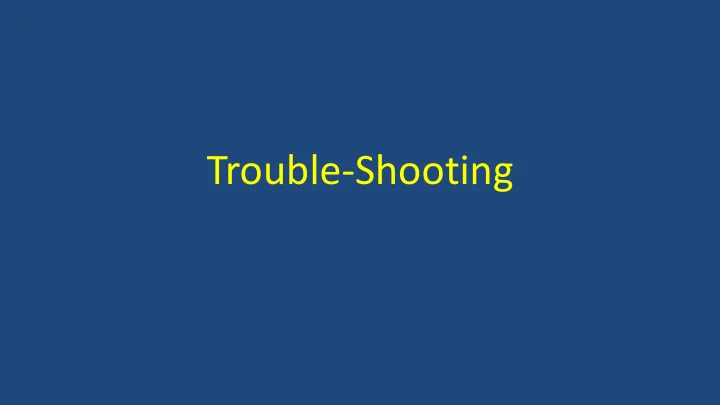

Trouble-Shooting
Three Parts 1. Have appropriate tools on-site 2. Check wire and connector integrity, fuses, and power source (generator, battery) -this is when the electrofisher is not working 3. Check maximum outputs to see if the control box is performing as expected from manufacturer specifications. - this applies when the electrofisher is working but not appearing to perform as it should
1. Have appropriate tools on-site • See Basic Field Tool Kit
2. Check Wiring, Connectors, Fuses, Power Source See • Backpack Troubleshooting video • Trouble-shooting and Maintenance PDF
3. Check Performance Scenario and analysis using the Boat Power Excel file to check performance. Also, bring up EF Goal Power Excel file to calculate ambient conductivity.
Scenario • A National Park Service biologist has an electrofishing boat with a 2650 Watt generator and a control box with specifications: 5600 Watt, 600V/41A, and 300V/45A. The boat has a single boom wired as the anode, the boat hull is wired as the cathode (see picture). On a test run in the James River, Missouri (specific conductivity = 590 μS /cm at 26 °C), the biologist started with 20% duty cycle and was able to get the peak outputs to 400 V and 26 amps without overloading (overload above these output levels). (continued)
Scenario (1) Are the maximum electrical outputs of this boat what are expected, that is, is the system performing to maximum? (2) What is the conductivity range that can be effectively electrofished with this unit? (3) Finally, the Park Service needs to electrofish a lake that has a water conductivity of 2,300 μS /cm. A high current option from the manufacturer will increase the capacity of the control box to 72 peak amps. Will this option allow successful fishing on this high conductivity lake? If not, what other options might you consider?
Is the system performing to the design specifications? 1. Convert specific water conductivity (Cs) to ambient conductivity (Ca). 2. Determine boat electrode resistance and convert to resistance at 100 µS/cm. Resistance on James River = Volts ÷ Amps Resistance at 100 µS/cm = R JR x (James R Ca ÷ 100) Go to EF Goal Power and Boat Power
Is the system performing to the design specifications? Yes, but the limiting power component is not the control box but the generator. The control box is working well.
What is the effective sampling water conductivity range? The range for the current set-up with a 2650 W generator is 6.7 – 108 Ohms or 86 µS/cm – 1,388 µS/cm
What Can Be Done to Effectively Sample a Lake Having a Ca = 2,300 µS/cm? • Depends on cost as well but let’s first say we purchased a larger generator (5600 x 1.2 = 6720W, so go with a 6,500 W) • Go to Boat Power (limiting factor now control box)
What Can Be Done to Effectively Sample a Lake Having a Ca = 2,300 µS/cm? • Increasing the output power to 5,600 Watts had a conductivity range of 86 µS/cm – 1575 µS/cm, very similar but being able to go to slightly higher conductivity (from 1388 µS/cm to 1575 µS/cm) • Now, go back to the original generator, and buy the 72 amp capacity upgrade • Go to Boat Power
What Can Be Done to Effectively Sample a Lake Having a Ca = 2,300 µS/cm? • Increasing the amp capacity to 72 amps with a 2,650 W generator will not achieve successful sampling in the high conductivity lake (estimated maximum effective sampling in 1388 µS/cm). • Now, incorporate the 6,500 W generator and the 72 amp capacity upgrade • Go to Boat Power
What Can Be Done to Effectively Sample a Lake Having a Ca = 2,300 µS/cm? • By matching the generator to the power capacity of the control box and upgrading to a 72 amp capacity, the upper range of effective sampling was extended to approximately 2,650 µS/cm. • Success!!
Recommend
More recommend